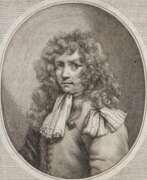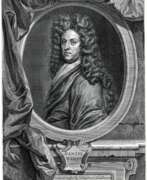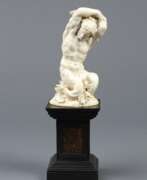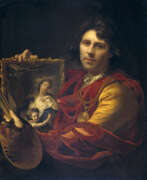Architects 17th century


Giovanni Lorenzo Bernini, an Italian artist, is celebrated as one of the most remarkable sculptors and architects of the Baroque era. Born in Naples in 1598, Bernini's family moved to Rome when he was a child, where he spent most of his life shaping the city's artistic landscape. His prodigious talent emerged early, evident in works created in collaboration with his father, Pietro Bernini, and soon caught the attention of influential patrons like Cardinal Scipione Borghese and Pope Paul V.
Bernini's work, characterized by dynamic and exuberant style, spanned various genres including portraiture, tomb sculpture, and religious and mythological representations. His ability to turn marble into lifelike figures and scenes, blending realism with emotional intensity, was unparalleled. Key works like "Aeneas and Anchises," "Pluto and Proserpina," and "Apollo and Daphne" exemplify this mastery.
Not confined to sculpture, Bernini was also an accomplished architect, contributing significantly to the architectural landscape of Rome. His involvement with St. Peter's Basilica, notably the Baldacchino and the design of St. Peter's Square, reflect his vision of merging architecture with sculpture to create a cohesive and impactful experience. His work on the Cornaro Chapel, including the famous "The Ecstasy of Saint Teresa," showcases this integration, combining sculpture, architecture, and light to stunning effect.
Bernini's influence extended beyond Rome. In 1665, he was invited by Louis XIV to France to work on the Louvre, though his architectural designs were not realized. His portrait bust of Louis XIV, however, remains a testament to his skill in capturing not just the likeness but the essence of his subjects.
A man of deep faith, Bernini's works often reflected his religious devotion, though he was also known for his caricatures and playful sketches, revealing a lighter side to his personality. His artistic legacy, characterized by the fusion of various art forms and the dramatic use of light and space, continues to influence and inspire.
For collectors and experts in art and antiques, Bernini's works remain a pinnacle of Baroque artistry, a testament to his innovative spirit and technical brilliance. His pieces, found in museums and galleries, continue to draw admiration for their emotional depth and exquisite craftsmanship.
Stay updated on new discoveries and sales of Bernini's works by signing up for our newsletter, exclusively focused on his art and upcoming auction events.


Thomas Blanchet, a distinguished French painter, sculptor, and architect, left an indelible mark on the Baroque era with his multifaceted talent. Blanchet's journey in art saw him transitioning from sculpture to painting under the guidance of Jacques Sarazin. His early years in Paris were enriched by the emerging Baroque influence and the Mannerism of the School of Fontainebleau, placing him among contemporaries like Simon Vouet.
Blanchet's formative years extended beyond French borders, as he ventured to Rome around 1645 to 1653. There, he immersed himself in the circle of Nicolas Poussin and visited the studios of Andrea Sacchi and Pietro da Cortona, earning high praise from Gianlorenzo Bernini. This period was marked by significant commissions, including works for Niccolò Guido di Bagno and the creation of engravings and mausoleums, notably in Venice for René de Voyer d'Argenson.
His repertoire was vast, encompassing classical themes, religious narratives, and architectural capriccios, as evidenced in works like "Time and Truth overcoming Envy and Discord" and "La Résurrection De Lazare". Blanchet's influence extended to Lyon, where he contributed to the city's cultural heritage through frescoes at the Collège de la Trinité, now Collège Ampère, and designed significant public and private spaces including the Palais de Roanne's grand chamber ceilings.
For collectors and experts in art and antiques, Thomas Blanchet's oeuvre represents a bridge between French and Italian Baroque, embodying the era's dramatic expressions and classical reverence. His works, found in both public spaces and museums, continue to be celebrated for their historical and artistic significance.
To stay informed about exhibitions, sales, and auctions related to Thomas Blanchet's works, signing up for our newsletter is recommended. This subscription ensures access to the latest insights and opportunities related to this Baroque master's enduring legacy.


Alonso Cano was a multifaceted Spanish artist, renowned for his remarkable contributions in painting, sculpture, and architecture. Born in Granada in 1601, Cano is often celebrated as the "Spanish Michelangelo", a testament to his diverse artistic talents and significant impact on the Baroque era. His career, marked by a blend of Italian Mannerism and Baroque style, was a journey through various Spanish cities, each phase contributing uniquely to his artistic evolution.
In Seville, Cano trained under Francisco Pacheco, where his initial works like "San Francisco de Borja" (Seville Museum of Fine Arts) displayed a blend of Tenebrism and a brighter, more lyrical color palette. This period also saw the birth of works like "La Visión de San Juan" (Wallace Collection, London), signaling a transition in his style. Madrid, however, marked a significant turn in Cano's career. His works for the Buen Retiro Palace and the Alcázar showcase an evolution towards elegant, dynamic Baroque forms with lighter tonalities, influenced by the 16th-century Venetian masters.
Cano's return to Granada in 1652 was a homecoming that not only reinvigorated the Granada School but also marked his most prolific period. His masterpieces during this time include the series of paintings on the life of the Virgin in Granada Cathedral, a remarkable testament to Baroque art. Notably, his "Inmaculada Concepción" (1648) and "Nacimiento de la Virgen" (1663-1664) in the Cathedral stand as crowning achievements of his painterly career.
Equally impressive is Cano's sculptural work, where his polychrome wooden statue of the Immaculate Conception (1655) in Granada Cathedral is often hailed as his magnum opus. Despite sculpture being a secondary focus to his painting, his works, such as the Inmaculada in San Julián Church, Sevilla, and the smaller, yet exquisitely crafted, Inmaculada of the facistol in Granada Cathedral, resonate with the delicate beauty pointing towards Rococo art.
Cano's architectural prowess is exemplified in the design of Granada Cathedral's façade, an original piece of Spanish Baroque architecture. His artistic journey was not just a personal endeavor but a pivotal influence in the transition of Spanish painting towards a more idealist trend alongside Velázquez.
For art collectors and experts, Alonso Cano's works remain a cornerstone of the Baroque era, showcasing a blend of dramatic realism and spiritual depth. His influence extends beyond the boundaries of Granada, leaving an indelible mark on the world of art and culture.
To stay informed about new discoveries, product sales, and auction events related to Alonso Cano's works, sign up for our updates. This subscription focuses solely on providing relevant news in the art and antiques realm, especially concerning Cano's invaluable contributions.


Luca Carlevaris was an Italian painter and engraver working mainly in Venice. He pioneered the genre of the cityscapes (vedute) of Venice, a genre that was later widely followed by artists such as Canaletto and Francesco Guardi.


Pietro da Cortona, born as Pietro Berrettini, was an eminent figure in the Italian Baroque movement. His multi-faceted genius encompassed painting, architecture, and design, earning him a reputation second only to Bernini in the Roman Baroque style. Cortona's journey in art commenced in Rome around 1612, where his talents flourished under the patronage of influential families like the Barberini.
Pietro da Cortona's masterful frescoes in the church of S. Bibiana, commissioned by Urban VIII, set the tone for his illustrious career. His most iconic work, the colossal fresco "Allegory of Divine Providence and Barberini Power" in the Gran Salone of the Palazzo Barberini, epitomizes his skill in creating grandiose, illusionistic art. This piece, commenced in 1633 and completed in 1639, is a testament to his belief in the epic scale of history painting, a view he defended in a notable debate with Andrea Sacchi.
In 1637, Pietro da Cortona's artistic journey took him to Florence at the behest of Ferdinand II de' Medici, Grand Duke of Tuscany. Here, in the Palazzo Pitti, he created frescoes for the Planetary Rooms, combining allegorical themes with lush stucco work, significantly influencing the Italian and French decorative arts.
Pietro da Cortona's contributions to architecture were equally significant. His architectural masterpiece, the church of SS. Martina e Luca in Rome, exemplifies his ability to create grand structures with a unified Baroque vision. His architectural prowess, though less correlated with his painting style, made a lasting impact through its emphasis on form rather than ornament.
For art collectors and enthusiasts, Pietro da Cortona's works offer a rich tapestry of Baroque artistry, blending grandeur, realism, and allegory. His frescoes, paintings, and architectural designs continue to captivate audiences, symbolizing the opulence and dynamism of the Baroque era.
To stay updated on the latest insights and collections related to Pietro da Cortona, consider subscribing to our updates. Stay informed about new sales, exhibitions, and auction events related to this master of the Baroque style.


Juan de Valdés Leal, born on May 4, 1622, in Seville, Spain, and passing away on October 15, 1690, was a Spanish painter and etcher celebrated for his Baroque era works. Valdés Leal is recognized for his dramatic and often somber thematic paintings which starkly contrasted with the serene styles of his contemporaries. His notable contributions include not just painting but also sculpture and architecture, indicating his versatile artistic talents. Educated under Antonio del Castillo in Córdoba, Valdés Leal's body of work covers religious and vanitas themes, emphasizing the transient nature of earthly life and the inevitability of death.
One of Valdés Leal's significant periods was after his return to Seville in 1656, where alongside Bartolomé Esteban Murillo, he co-founded the Seville Academy of Art. This period marked the creation of some of his most poignant works, including "In ictu oculi" and "Finis gloriae mundi," which he painted for the Charity Hospital in Seville. These works are revered for their deep contemplation on mortality and the fleeting nature of worldly success.
Valdés Leal's legacy extends beyond his own lifetime, with several of his children, including Lucas, Juan, Maria, and Laura, following in his artistic footsteps. His influence persisted in Seville's artistic landscape, especially in religious art, where his pieces continued to inspire both awe and reflection.
For collectors and experts in art and antiques, Juan de Valdés Leal's work offers a profound glimpse into the Baroque era's complex interplay of beauty, spirituality, and the macabre. His paintings, many of which reside in museums and private collections worldwide, remain a testament to his skill and depth as an artist.
To stay updated on sales and auction events related to Juan de Valdés Leal's works, signing up for updates can provide exclusive access to the latest available pieces and related events, ensuring enthusiasts and collectors don't miss out on acquiring or viewing works by this illustrious artist.


Paul Decker the Elder was a German architect and engraver.
He created a series of copperplate engravings depicting designs for ideal princely and royal architecture, including palaces, fountain cascades, and gardens. Decker's work was published in three volumes (1711-1716) under the title Fürstlicher Baumeister oder Architectura Civilis.


Santi di Tito was one of the most influential and leading Italian painters of the proto-Baroque style – what is sometimes referred to as "Counter-Maniera" or Counter-Mannerism. Santi completely rejected the maniera of Bronzino, and embraced a classical Reformist and naturalistic style. Santi's mature style is reflected in his masterpiece of the Vision of Saint Thomas Aquinas, also known as Saint Thomas Dedicating His Works to Christ located in the church of San Marco in Florence.


Martin Hermann Faber was a German painter, architect, and cartographer. He was also a copper engraver in Rome. He lived and worked most of his life in Emden, where he still remains one of the most respected and significant artistic personalities of the city.


Giovanni Battista (Giambattista) Foggini was an Italian sculptor active in Florence, renowned mainly for small bronze statuary.
Foggini's pupils included Fernando Fuga, his nephew Filippo della Valle, Balthasar Permoser, Giovacchino Fortini and Giovanni Baratta. Massimiliano Soldani Benzi was a contemporary student with Foggini in Rome and also active in small bronze sculpture.


Frans Geffels, known in Italy as Francesco Geffels (25 August 1624 – 18 February 1694) was a Flemish painter, printmaker, architect, stage designer and designer of ephemeral structures for solemn and festive occasions. After training in his native Antwerp, he was mainly active in Mantua, where he was prefetto delle fabbriche to the Duke, a role that gave him the direction of the artistic and construction activities undertaken by the Ducal court. He worked also on projects for the local aristocratic class of Mantua. In addition, he completed projects for the Liechtenstein princes and for the imperial court in Vienna.
He was both a canvas and fresco painter. He created portraits, history subjects, military scenes, architectural scenes and genre art, in particular merry companies. Geffels is mainly remembered as the designer of some of the key examples of Baroque architecture in Mantua.


Carlo Maratta, an Italian painter, was a prominent figure in the Roman school of art during the late 17th century. Known for his classical approach to Baroque painting, Carlo Maratta's works were deeply influenced by the styles of Raphael and Andrea Sacchi, blending classical grandeur with Baroque expressivity. His training under Sacchi and subsequent exposure to Pietro da Cortona's coloristic style significantly shaped his artistic development.
Carlo Maratta's career flourished with a series of public and official commissions, making him a leading painter in Rome, especially after Bernini's death in 1682. His portfolio includes religious paintings, altarpieces, portraits, and fresco cycles, with a notable emphasis on paintings of the Madonna and Child, which reinterpreted High Renaissance motifs. His work was highly esteemed across Europe, influencing not only Italian art but also attracting the attention of English visitors on the Grand Tour.
One of Carlo Maratta's significant contributions to the art world was his involvement in painting restoration towards the end of his career, including works by Raphael and Carracci. This phase underscored his deep connection to the classical art tradition. Maratta passed away in Rome in 1713, leaving behind a legacy that continued to be celebrated in art history.
For art enthusiasts, collectors, and experts, Carlo Maratta's work offers a window into the transition between the Baroque and the emerging Rococo style, embodying a blend of dynamism and classical restraint. His paintings, many of which remain in situ in Roman churches, offer a testament to his enduring influence on Baroque classicism.
To stay updated on exhibitions and insights into Carlo Maratta's works, art aficionados are encouraged to subscribe for updates, ensuring access to the latest research and opportunities to view his celebrated works in museums and galleries around the world.


Claes Moeyaert, or Nicolaes Cornelisz. Moeyaert, or Claes Cornelisz. Moeyaert, or Claes Cornelisz. Moeyaert, was a Dutch Baroque painter.
Moeyaert was a very prolific painter, he painted many biblical and mythological scenes with a special emphasis on dramatic moments. He followed Adam Elsheimer, Peter Lastman, Jan and Jacob Pinas, coming under the influence of Rembrandt himself in the mid-1630s. Moeyaert also designed Amsterdam's triumphal arch for the arrival of Maria de' Medici.


Pietro Novelli was an Italian painter of the Baroque period, active mainly in Palermo. Also known as il Monrealese or Pietro "Malta" Novelli to distinguish him from his father, Pietro Antonio Novelli I. He was also nicknamed by contemporaries as the Raphael of Sicily.


Cornelis Cornelisz. van Haarlem was a Dutch painter, draftsman, and architect. Along with Karel van Mander and Hendrik Goltzius, he is one of the leading artists of the Dutch Mannerism of the Haarlem School, more commonly referred to as Cornelis van Haarlem.


Domenico Parodi was an Italian late Baroque painter, sculptor, and architect.
His father was the famous Genoese sculptor Filippo Parodi and the painter Giovanni Battista Parodi was his younger brother.
Parodi is known for his fantastic decorative ceilings in religious buildings and palaces depicting mythological and allegorical subjects. He created commissioned busts and portraits, tombstones, altars, and sculptures. He also continued the sculptural tradition of his father, carving figures of Apollo, Ariadne, Bacchus and Diana in marble in elaborate techniques.


Jacob van Campen was a Dutch painter and architect of the Golden Age and a member of the Guild of St. Luke of Haarlem. He is one of the progenitors of Dutch Classicism in architectural style. In addition to houses and palaces, van Campen also designed a number of churches.


Frans van Sterbeeck or Johannes Franciscus van Sterbeeck was a Flemish clergyman, botanist and mycologist, painter, architect and historian.
In addition to his work as a priest, van Sterbeeck had a passion for botany and corresponded with prominent botanists of his time, including John Ray. In particular, he made a serious study of fungi and as a result produced a work entitled Theatrum fungorum oft het tooneel der Campernoelien, published in Antwerp in 1675. This richly illustrated book in Dutch describes the edible and poisonous species of mushrooms.
Frans van Sterbeeck also designed the main altar of the Antwerp Preaching Church and the portal of the Beguinage Church in 1680, and wrote two works on historical subjects.


Hans Vredeman de Vries was a Netherlandish painter and printmaker, decorative artist, architect and Renaissance engineer.
After studying the works of Vitruvius and Sebastiano Serlio and putting in a great deal of labor himself, Vredeman became known throughout Europe as a specialist in perspective. As an architectural theorist, he was most famous for his varied designs of invented views of cities and buildings shown in carefully considered linear perspective. These were apparently created as models for architects.
In 1575-1586 Hans Vredeman de Vries was appointed city architect of Antwerp and was responsible for the fortifications of the city. He then worked in Hamburg, Danzig, Prague and Amsterdam. He is also known for his 1583 publication on garden design and books with many examples of ornamentation and perspective.
His son Salomon Vredeman de Vries (1556-1604) was also an artist.

































































